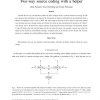Free Online Productivity Tools
i2Speak
i2Symbol
i2OCR
iTex2Img
iWeb2Print
iWeb2Shot
i2Type
iPdf2Split
iPdf2Merge
i2Bopomofo
i2Arabic
i2Style
i2Image
i2PDF
iLatex2Rtf
Sci2ools
TIT
2010
2010
Two-way source coding with a helper
Consider the two-way rate-distortion problem in which a helper sends a common limited-rate message to both users based on side information at its disposal. We characterize the region of achievable rates and distortions where a Markov form (Helper)-(User 1)-(User 2) holds. The main insight of the result is that in order to achieve the optimal rate, the helper may use a binning scheme, as in Wyner-Ziv, where the side information at the decoder is the "further" user, namely, User 2. We derive these regions explicitly for the Gaussian sources with square error distortion, analyze a trade-off between the rate from the helper and the rate from the source, and examine a special case where the helper has the freedom to send different messages, at different rates, to the encoder and the decoder. The converse proofs use a technique for verifying Markov relations via undirected graphs.
Related Content
| Added | 22 May 2011 |
| Updated | 22 May 2011 |
| Type | Journal |
| Year | 2010 |
| Where | TIT |
| Authors | Haim H. Permuter, Yossef Steinberg, Tsachy Weissman |
Comments (0)

